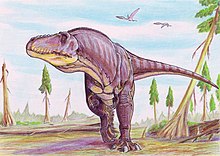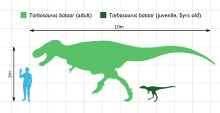Tarbosaurus
Tarbosaurus ('fearsome lizard', from Ancient Greek τὸ τάρβος, -εος tarbos, German 'Schrecken, Furcht' and ὁ σαῦρος, σαύρου sauros, German 'Echse') is a genus of theropod dinosaur in the family Tyrannosauridae that lived in Asia during the Late Upper Cretaceous (Maastrichtian).
Fossils come mainly from Mongolia (Nemegt Formation), but fragmentary remains have also been discovered in parts of China. Although several species have been named, only one species, the type species Tarbosaurus bataar, is recognized today. Some experts consider Tarbosaurus to be an Asian representative of the North American genus Tyrannosaurus - if this is true, the genus Tarbosaurus would be invalid.
Tarbosaurus and Tyrannosaurus are considered closely related, although some paleontologists consider Alioramus, also from Mongolia, to be Tarbosaurus' closest relative. Like most known tyrannosaurids, Tarbosaurus was a large bipedal carnivore with a large skull and very small, two-fingered arms-the latter were smaller in Tarbosaurus relative to its body size than in any other tyrannosaurid.
Tarbosaurus lived in a floodplain crisscrossed by rivers. In this habitat, he was at the top of the food pyramid and likely hunted large dinosaurs such as the hadrosaurid Saurolophus or the sauropod Nemegtosaurus. It is known from dozens of finds, including complete skulls and skeletons, which allowed scientific studies of its phylogeny, brain structure, and cranial mechanics.
Features
Tarbosaurus was among the largest tyrannosaurids and was only slightly smaller than Tyrannosaurus. The largest known individuals were between ten and twelve meters long and held their heads up to five meters above the ground. A weight estimate of an adult individual has never been published, but it is believed that Tarbosaurus was slightly lighter in relation to Tyrannosaurus.
The largest known Tarbosaurus skull is more than 1.3 meters long, larger than any other tyrannosaurid except Tyrannosaurus. The skull was similar in height to that of Tyrannosaurus, but not as wide, especially at the back of the head, so the eyes were not directly forward - suggesting that Tarbosaurus, unlike Tyrannosaurus, could not see spatially. Between 60 and 64 teeth sat in the jaw; slightly more than Tyrannosaurus, but fewer than smaller tyrannosaurids such as Gorgosaurus or Alioramus. While most of the teeth were oval in cross-section, the teeth of the premaxillary at the anterior end of the maxilla had a "D"-shaped cross-section. This heterodonty is characteristic of the entire family. The longest teeth were in the maxilla and had crowns up to 85 millimeters long. The mandible was stabilized, as in Alioramus, by a ridge on the outer surface of the angular bone, which was hooked to the posterior surface of the dentary bone. This mechanism is absent in other tyrannosaurids, whose jaws were thus more flexible.

Living reconstruction of Tarbosaurus

Tarbosaurus bataar in size comparison with a human being
Systematics
Tarbosaurus is classified within the family Tyrannosauridae and within the subfamily Tyrannosaurinae. Other members of the Tyrannosaurinae include Tyrannosaurus and the earlier Daspletosaurus from North America, and probably Alioramus from Asia. The Tyrannosaurinae differs from the other subfamily, the Albertosaurinae, in its more robust build and proportionally larger skulls and longer femurs.
Tarbosaurus bataar was originally described as a species of Tyrannosaurus, which has been supported by more recent studies. Other scientists prefer to separate the two taxa and consider them merely sister genera. In contrast, a 2003 cladistic analysis based on cranial features considers Alioramus to be the closest relative of Tarbosaurus, as both genera share cranial features not found in other tyrannosaurines. This theory suggests different lineages in Asia and North America; if proven, synonymy between Tyrannosaurus and Tarbosaurus would be ruled out.
| Tyrannosauridae |
| ||||||||||||||||||||||||||||||
Cladogram of the Tyrannosauridae according to Holtz, 2004
| Tyrannosauridae |
| ||||||||||||||||||||||||||||||||||||
Alternative cladogram of the Tyrannosauridae according to Currie and others 2003
Questions and Answers
Q: What is Tarbosaurus?
A: Tarbosaurus is a large carnivorous theropod dinosaur from Asia, especially Mongolia and China.
Q: When did Tarbosaurus flourish?
A: Tarbosaurus flourished between 70 and 65 million years ago, at the end of the Cretaceous period.
Q: What was the habitat of Tarbosaurus like?
A: The habitat of Tarbosaurus was a humid floodplain criss-crossed by river channels.
Q: Where was Tarbosaurus in the food chain?
A: Tarbosaurus was a predator at the top of the food chain.
Q: What did Tarbosaurus probably prey on?
A: Tarbosaurus probably preyed on other large dinosaurs like the hadrosaur Saurolophus or the sauropod Nemegtosaurus.
Q: How many specimens of Tarbosaurus have been found?
A: Dozens of specimens of Tarbosaurus have been found.
Q: What have scientists been able to study with Tarbosaurus remains?
A: Scientists have been able to study the phylogeny, skull mechanics, and brain structure of Tarbosaurus with its remains.
Search within the encyclopedia